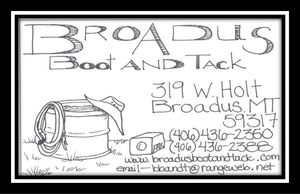30 Years Ago
From the Examiner Files
August 29, 2019
Thursday, August 31, 1989
Area ranchers prepare cattle for great Centennial drive
Latigo-branded M-89 Longhorn Centennial Trail Drive cattle were ear tagged and weighed on Tuesday, August 29 at the Powder River County corrals near Broadus.
Those fortunate enough to see the continuous unloading, sorting, weighing, ear tagging and roping say, “It was a sight I never would have expected to see, and truly a once in a lifetime show.”
The longhorns and cowhands were a mind-boggling show… there are no words to describe it. Those huge horns on the powerful steers looked entirely formidable to those unaccustomed to handling Longhorns.
While the Examiner sends words by wire, unfortunately they cannot send photos by wire and shots of just a bit of the action will be shown next week. These were not isolated scenes for the day, but just little “hitches” like real cowhands deal with on ranches.
Designated cowboys for Carter and Powder River Counties, Jim Wilson and Charles Patten chose Ward Patten to assist in the “corral work.” These were the only three riders and the host of intrepid gentlemen on foot among the Longhorns were completely casual and at home, moving about in a small pen and shoving Longhorns aside, pushing giant horns out of their faces and twisting tails.
“Look, there’s nothing to worry about,” Maxine Patten said. “These big fellows are all gentle and when they are on the prod from trucking and being shoved about it’s easy to see and the fellows let them settle down a bit.”
Nan Stevens of Circle Bar had two big fellows there, with horns too wide to go through the chute gate. So, they were roped from a saddle horse and tagged at the same time on the scales. The cowhands try to avoid roping them, as steers find it irritating, but Mrs. Stevens said, “They’re really gentle as kittens. One of them is a bum calf that I pail fed.” He had outgrown “calf” stage by what appeared to be about 1800 pounds of Longhorn.
The thing to remember is that these opinions and seemingly casual handling is a long-studied habit. Those who haven’t been trained to Longhorns do well to keep their distance.
One huge steer went over the fence in protest to the chute. He had Charles Patten’s rope on him before he was well up. Jim Wilson and Ward Patten left their posts inside and spurred around to take the rope and “lead” the Longhorn around to re-enter by a gate, with John Smith on foot twisting his tail. He really led quite well, however.
A smaller Latigo-consigned steer went over the fence and headed across the Big Powder Bridge and up town before Charles got his rope returned. Jim, Charles and Ward took after him, with Charles getting a rope on him just at the Broadus city limits. Ward had the foresight to hurriedly stick his horse in a horse-trailer, so they loaded the feisty animal alongside the highway and returned to more action at the corrals.
All these things are done coolly and quietly, and soothing words and handling used wherever there is time. In the race for the city streets there wasn’t time. The three saddle horses take the proceedings in stride as though it were just part of a day’s work and really nothing to get excited about.
The only area where there seemed to be no differing opinions between people and livestock was in the unloading. The Longhorns agreed that it was time to unload.
The Latigo cattle are slated to be loaded and taken to Roundup at 10 o’clock Tuesday evening. Working from 9 a.m. to 1 p.m., there were 19 head tagged with the correct color of tags and weighed as well as brand inspected by Gary Gatlin. Charles Patten, who had just returned from uptown with the second runaway remarked, “But that’s just because things have gone smoothly. They’ll likely slow down.” This was at 1 o’clock, with action having gone on for four hours, and pens and pens of Longhorns still waiting for first the chute and then the scale.
Those people who did not notice the date of the ear tagging in last week’s Examiner missed the sight of a one-time-only experience at the county yards on Tuesday.
This week is a bit like Christmas Eve is for the kids for the chairpersons of the drive, and for all the ranchers, male and female, who have worked for 20 months to see the Centennial Trail Drive become reality.
Added to the designated cowboy (one from each county) are 44 other hands chosen by Latigo trail boss Jay Stovall of Billings. They have until the weekend to make their appearance in Roundup, if they so choose.
Covered wagons will be hauled to Roundup from this area on August 31, September 1 and 2. In case of accident to any cowboy named, there will be alternates among the wagon outriders.
Bookkeeping on Tuesday was somewhat hectic, as there are four different ribbons used in tagging.
Red indicates “Sell at Auction.” Blue indicates “Sell at Auction/Owner’s hide.” Green means “Owner keeps live animal.”
On cattle other than those white tagged, it was understood, only two percent of the funds earned in the sale of the stock will be donated to the Youth Endowment Fund and the balance returned to the rancher.
It is easily deduced that bookkeeping of the project has been a steady job.
In other information from Maxine Patten (bookkeeper), United States Senator Conrad Burns and Representative Max Baucus will be participating in the drive. State Representative Marian Hanson will also have prominent placing with she and husband Darrel in the covered wagon trek.
The M-89 brands on the hides will be family mementos. They will be professionally handled and probably hung on the living room wall, entirely legal within regulations of the drive… not at all like those hides that used to be seen handing on corral fences to cure, with the brand cut out and buried.
It’s the Great Montana Centennial Cattle Drive, 1989 and its scheduled to start September 4 in Roundup and wind up in Billings on September 9th. The drive will be seen on network television and an estimated 190 million viewers will see the action. It will be the largest single gathering of horses and riders since in the United States since the Battle of Gettysburg. It will be equivalent of the eight largest city in the state of Montana moving ten miles a day for a week. Chuck wagon cooks will prepare and serve over 90,000 meals during the week.
The drive begins with a parade of 5000 cowboys and cowgirls, 300 wagons, and cattle from across the state. Then the long trek to Billings across the open prairie and hills of typical Eastern Montana range land.








Reader Comments(0)